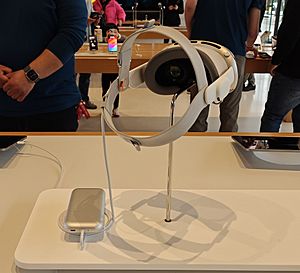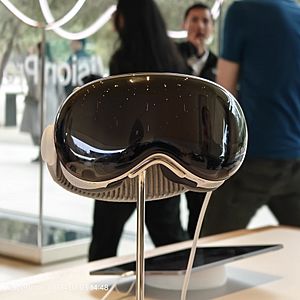Apple Vision Pro facts for kids

Apple Vision Pro headset and battery pack
|
|
| Codename | N301 |
|---|---|
| Developer | Apple Inc. |
| Manufacturer | Luxshare |
| Type | Standalone mixed reality headset |
| Release date | US: February 2, 2024 |
| Introductory price | US$3,499 |
| Operating system | visionOS (iOS-based) |
| System on a chip | Apple M2 (8-Core, 16-Core Neural Engine), Apple R1 (12ms photon latency, 256GB/s memory bandwidth) |
| Memory | 16GB |
| Storage | 256 GB, 512 GB, 1 TB |
| Display | Internal: ~23 MP total (equivalent to WUHD for each eye) dual micro-OLED (RGBB π subpixel geometry) up to 100 Hz refresh rate External: "EyeSight" curved lenticular OLED |
| Graphics |
|
| Sound | Surround sound speakers, 6 beamforming microphones |
| Input | 6DoF inside-out tracking, photogrammetry, hand gesture recognition through 12 built-in cameras and LiDAR, eye tracking and voice input |
| Camera | Stereoscopic 3D main camera system, 18 mm, ƒ/2.00 aperture, 6.5 stereo megapixels |
| Connectivity | Wi‑Fi 6 (802.11ax), Bluetooth 5.3 |
| Power | External proprietary battery with 2–2.5 hours of use |
| Current firmware | visionOS 1.0.2 |
| Mass | 600–650g (excluding battery) |
Apple Vision Pro is a mixed reality headset developed by Apple Inc. Announced on June 5, 2023, at Apple's Worldwide Developers Conference, pre-orders began on January 19, 2024 and the product launched on February 2, 2024 in the United States. A worldwide launch has yet to be scheduled. It is Apple's first new major product category since the release of the Apple Watch in 2015.
Apple markets the Vision Pro as a "spatial computer" where digital media is integrated with the real world, and physical inputs—such as motion gestures, eye tracking, and speech recognition—can be used to interact with the system. Apple does not market the device as being a virtual reality headset, and has avoided the use of the terms "virtual reality" and "augmented reality" when discussing the product in presentations and marketing.
The device runs visionOS, a mixed-reality operating system derived from iOS frameworks using a 3D user interface; it supports multitasking via windows that appear to float within the user's surroundings, as seen by cameras built into the headset. A dial on the top of headset can be used to mask the camera feed with a virtual environment to increase immersion. The OS supports avatars (officially called "Personas"), which are generated by scanning the user's face; a screen on the front of the headset displays a rendering of the avatar's eyes ("EyeSight"), which are used to indicate the user's level of immersion to bystanders, and assist in communication.
Contents
History
Development
In May 2015, Apple acquired the German augmented reality (AR) company Metaio, originally spun off from Volkswagen. That year, Apple hired Mike Rockwell from Dolby Laboratories. Rockwell formed a team called the Technology Development Group including Metaio co-founder Peter Meier and Apple Watch manager Fletcher Rothkopf. The team developed an AR demo in 2016 but was opposed by chief design officer Jony Ive and his team. Augmented reality and virtual reality (VR) expert and former NASA specialist Jeff Norris was hired in April 2017. Rockwell's team helped deliver ARKit in 2017 with iOS 11. Rockwell's team sought to create a headset and worked with Ive's team; the decision to reveal the wearer's eyes through a front-facing eye display was well received by the industrial design team.
The headset's development experienced a period of uncertainty with the departure of Ive in 2019. His successor, Evans Hankey, left the company in 2023. Senior engineering manager Geoff Stahl, who reports to Rockwell, led the development of its visionOS operating system, after previously working on games and graphics technology at Apple. Apple's extended reality headset is meant as a bridge to future lightweight AR glasses, which are not yet technically feasible. In November 2017, Apple acquired Canadian MR company Vrvana for $30 million. The Vrvana Totem was able to overlay fully opaque, true-color animations on top of the real world rather than the ghost-like projections of other AR headsets, which cannot display the color black. It was able to do this while avoiding the often-noticeable lag between the cameras capturing the outside world while simultaneously maintaining a 120-degree field of view at 90 Hz. The Totem also used IR illuminators and infrared cameras to perform spatial and hand tracking.
According to leaker Wayne Ma, Apple was originally going to allow macOS software to be dragged from the display to the user's environment but was scrapped early on due to the limitations of being based on iOS and noted that the hand-tracking system was not precise enough for games. Workers also discussed collaborations with brands such as Nike for working out with the headset, and others investigated face cushions that were better suited for sweaty, high-intensity workouts, but was scrapped due to the battery pack and the fragile screen. A feature called "co-presence"; a projection of a FaceTime user's full body, was also scrapped due to unknown reasons.
Unveiling and release
In May 2022, Apple executives previewed the device, including CEO Tim Cook. The company began recruiting directors and creatives to develop content for the headset in June. One such director, Jon Favreau, was enlisted to bring the dinosaurs on his Apple TV+ show Prehistoric Planet to life. By April, Apple was also attempting to attract developers to make software and services for the headset. Apple filed over 5,000 patents for technologies which contributed to the development of Vision Pro.
The Apple Vision Pro was announced at Apple's 2023 Worldwide Developers Conference (WWDC23) on June 5, 2023, to launch in early 2024 in the United States at a starting price of US$3,499.
On June 6, the day after the announcement, Apple acquired the AR headset startup Mira, whose technology is used at Super Nintendo World's Mario Kart ride. The company has a contract with the United States Air Force and Navy. Eleven of the company's employees were onboarded.
On January 8, 2024, Apple announced that the release date of the Vision Pro in the United States would be on February 2, 2024. Estimates of initial shipments ranged from 60,000–80,000 units. Pre-orders began on January 19, 2024 at 5:00 a.m. PST and the launch shipments sold out in 18 minutes. Apple sold up to 200,000 units in the two week pre-order period, surpassing expectations of about 160,000 units. A majority of these units will be shipped five to seven weeks after launch day.
Specifications
Hardware
Apple Vision Pro has a curved laminated glass display on the front, an aluminum frame on its sides, a flexible cushion on the inside, and a removable, adjustable headband. The frame contains five sensors, six microphones, and 12 cameras. Users see two 1.41-inch (3.6 cm) micro-OLED displays with a total of 23 megapixels usually running at 90 FPS through the lens but can automatically adjust to 96 or 100 FPS based on the content being shown. The eyes are tracked by a system of LEDs and infrared cameras, which form the basis of the device's iris scanner named Optic ID (used for authentication, like the iPhone's Face ID). Custom optical inserts are supported for users with prescription glasses, which will attach magnetically to the main lens and are developed in partnership with Zeiss. The device's speaker is inside the headband and is placed directly over the user's ears. It can also virtualize surround sound. During the ordering process, users must scan their face using an iPhone or iPad with Face ID for fitting purposes; this can be done via the Apple Store app or at an Apple Store retail location.
The Vision Pro uses the Apple M2 system on a chip. It is accompanied by a co-processor known as Apple R1, which is used for real-time sensor input processing. The device can be purchased with three internal storage configurations: 256 GB, 512 GB, and 1 TB. It can be powered by an external power supply, a USB-C port on a Mac, or a battery pack rated for two and a half hours of use. The battery pack connects to the headset using an unremovable 12-pin locking variant of the Lightning connector.
The user's face is scanned by the headset during setup to generate a persona—a realistic avatar used by OS features. One such feature is "EyeSight", an outward-facing display which displays the eyes of the user's persona. Its eyes appear dimmed when in AR and obscured when in full immersion to indicate the user's environmental awareness. When someone else approaches or speaks, even if the user is fully immersed, EyeSight shows their persona's virtual eyes normally and makes the other person visible.
A digital crown dial on the headset is used to control the amount of virtual background occupying the user's field of view, ranging from a mixed-reality view where apps and media appear to float in the user's real-world surroundings, to completely hiding the user's surroundings.
Accessories
First-party consumer accessories for the Apple Vision Pro include a 199 USD travel bag, 99 USD Apple-manufactured Zeiss optical inserts for users with farsightedness, a 199 USD light seal, and a 29 USD light seal cushion. The only official third-party accessory available at launch is a battery holder made by Belkin.
A first-party adapter costing 299 USD is available and can only be purchased by registered, paid Apple Developer accounts, that replaces the right head-strap connection and adds a USB-C port for use by developers. Code from diagnostics tools have revealed that the adapter is capable of interacting with the Vision Pro in a diagnostic mode.
Software
Apple Vision Pro runs visionOS (internally called xrOS before a last-minute change ahead of WWDC), which is derived primarily from iOS core frameworks (including UIKit, SwiftUI, and ARKit), and MR-specific frameworks for foveated rendering and real-time interaction.
The operating system uses a 3D user interface navigated via finger tracking, eye tracking, and speech recognition. Users can select elements by looking at it and pinching two fingers together, move the element by moving their pinched fingers, and scroll by flicking their wrist. Apps are displayed in floating windows that can be arranged in 3D space. visionOS supports a virtual keyboard for text input, the Siri virtual assistant, and external Bluetooth peripherals including Magic Keyboard, Magic Trackpad, and gamepads. visionOS supports screen mirroring to other Apple devices using AirPlay.
visionOS supports vision apps from App Store, and is backward compatible with selected iOS and iPadOS apps; developers are allowed to opt out from visionOS compatibility. At launch, visionOS supports over 1 million iOS and iPadOS apps and 600 native visionOS apps. Missing from this selection is Netflix, Spotify, and YouTube. Analysts suggested that this may have resulted from the companies' strained relationships with Apple over App Store policies such as mandatory 30% revenue sharing (including associated antitrust allegations). In an interview, Netflix co-CEO Greg Peters stated that Vision Pro was too niche to for the company to support at this time, but that "we're always in discussions with Apple to try and figure that out". YouTube has announced that a visionOS app is "on [the] roadmap".
visionOS can mirror the primary display of a macOS device via the "Mac Virtual Display" feature; the Mac can also be controlled using peripherals paired with the headset.
See also
 In Spanish: Apple Vision Pro para niños
In Spanish: Apple Vision Pro para niños
- Microsoft HoloLens
- Meta Quest Pro
- Google Glass


